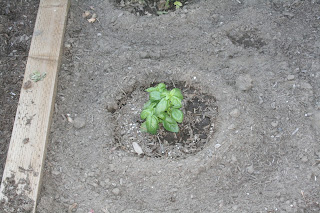As I feared when I started this blog, I have come to a dry spell in wit and humor. As of this moment I have started three different articles on three different topics, and while okay, they just seem to be falling flat. I think there is a technical term for this, writers block.
Since I am feeling rather dried up I thought it would be a great time to talk about watering. Of course the pun was intended but I am seriously not feeling funny. Watering doesn’t need to be funny. I know you won’t be laughing once you get your first, post planting, water bill. I’m serious, you think gas is expensive, just wait. At least when you buy gas you can watch the meter run. Not so for the water bill. Word to the wise, sit before you open it.
Since I can think of nothing witty to say let’s get to it. Conserve water when you garden! Sounds like an oxymoron doesn’t? I just love a good oxymoron – open secret, clearly confused, living dead, definite maybe (a mother’s favorite), freezer burn (I tried to explain that one to my daughter the other day, now that was funny), and something I may use in this post - constant variable.
I don’t really know if there are watering rules for a vegetable garden. I guess I never bothered to look into that. It doesn’t matter though, because as is the case with most everything else, I will do my own thing. I am going to break my watering tips down into a bulleted list for ease of reading:
- Make troughs out of your rows. A picture is worth a thousand words so take a look at the picture below. This one is of my newly planted carrots. By building these irrigation type troughs the water stays where I put it and doesn’t run all over the place. Note I planted the seeds in the "valley" not on the hill.
- Build "wells" around your plants. Once your seeds mature into larger plants create a “well” around the plant. See the picture below of my basil. Do this for single plants like herbs, cucumbers, tomatoes and squash. This way you contain the water to just the plant roots and nothing else.
- Water early in the morning before the sun gets too hot. Watering early allows the plants to absorb more, with less water being lost to evaporation. In the summer this usually means watering before 8 am.
- Mulch, mulch, mulch. Keeping the base of your plants covered with good mulch helps retain moisture and also prevents loss of water to evaporation. I can’t stress how great mulch is. It also helps prevent weed growth.
- In some instances you can water infrequently by soaking plants really well every three or four days. This encourages them to become deeply rooted as they seek moisture. But watch for drooping leaves as this is a good indication of when you have made plants go too long without water. And be careful with infrequent watering because some varieties, like cucumbers, really need lots of water to produce well. Tomatoes on the other hand don’t really like a lot of water. Take time to learn what your veggies like. Weather also plays an important role, the hotter the temperatures the more often you will need to hydrate your garden.
- Water the roots, not the plant. You should never use sprinklers in your vegetable garden. The leaves aren’t the parts that are absorbing the watering. Besides losing a lot of water to evaporation, keeping the top part of the plant wet can promote mold and other fungi. I use soaker hoses in my rows of vegetables for drip irrigation. A soaker hose is simply a hose with lots of really tiny holes in it that “leaks” water into the ground slowly.
I find that creating a watering schedule is helpful but be prepared to be flexible based on the weather. Hotter days require more water, where as cooler temperatures allow you to get away with skipping a day or two. Remember the oxymoron – constant variable- and you will be fine. I am very busy and have been known to forget to water the garden. By creating a basic schedule and keeping a simple journal I don’t have to remember when or what plant I watered last, I just look at the schedule and make quick notes when I’ve made an adjustment. I can hear some of you groaning already, “now she wants us to write things down and make a schedule, how is that simple?” Well first of all I said make quick notes not write a four page essay, so quit whining. Second of all I do mean to keep things simple but simple doesn’t mean effortless, so quit whining! We aren’t done talking about a garden journal either. We are done talking about watering, for now.

